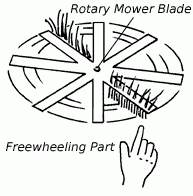
(Source: The Ohio State University Extension)
Use the following format to cite this article:
Mechanical hazards: Freewheeling parts. (2013). Farm and Ranch eXtension in Safety and Health (FReSH) Community of Practice. Retrieved from http://www.extension.org/pages/64419/mechanical-hazards:-freewheeling-parts.
Freewheeling parts are parts of a machine that continue to move even after power to the machine has been turned off. Freewheeling parts continue to move because some machines require large amounts of rotational energy to operate smoothly in varying conditions, and the freewheeling parts cannot come to an abrupt stop without the application of a braking system of some type. The heavier the rotating part, the faster and longer it will continue to rotate or move after the power is shut off.
Examples of freewheeling parts include:
- flywheels on small square balers
- rotary mower blades
- cutter heads of forage harvesters
- hammer mills of feed grinders
- fans on silage blowers
Potential injuries from freewheeling parts include:
- cuts
- abrasions
- bruises
- entanglement
- crushing
- amputations
Safety Precautions When Working around Freewheeling Parts
You can reduce your risk of an incident by adhering to the following safety precautions:
- Be aware of any freewheeling parts on your equipment and keep guards and shields in place.
- Before carrying out any activity in proximity to a freewheeling part:
- shut off the tractor,
- disengage the power take-off (PTO), and
- wait for the freewheeling part to come to a complete stop.
- Never touch a freewheeling part while it is moving, even if it is moving very slowly.
- Listen to the freewheeling part—most freewheeling parts make a whirring or humming sound when they are rotating.
Resources
View the video about freewheeling parts from the Pennsylvania State University’s Agricultural Safety and Health Program.
Use the following format to cite this article:
Mechanical hazards: Freewheeling parts. (2013). Farm and Ranch eXtension in Safety and Health (FReSH) Community of Practice. Retrieved from http://www.extension.org/pages/64419/mechanical-hazards:-freewheeling-parts.
Sources
Agricultural equipment and machine hazards. (2016) The Ohio State University. Retrieved from http://agsafety.osu.edu/programs/cfaes-osha/ag-equipment-machine-hazards.
Cyr, D. and Johnson, S. (n.d.) Dangers of agricultural machinery. Maine Farm Safety Program. Retrieved from http://extension.umaine.edu/publications/2316e/.
Harshman, W., Yoder, A., Hilton, J., and Murphy, D. (2011) Mechanical hazards: HOSTA Task Sheet 3.1. Pennsylvania State University Agricultural and Biological Engineering Department. Retrieved from http://articles.extension.org/sites/default/files/Version%203.%20January….
